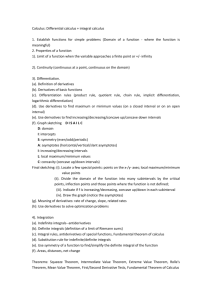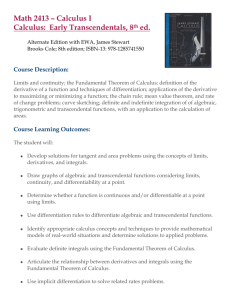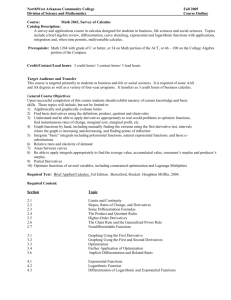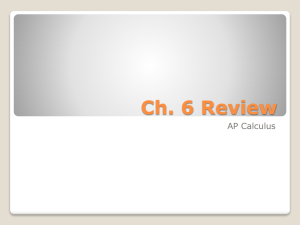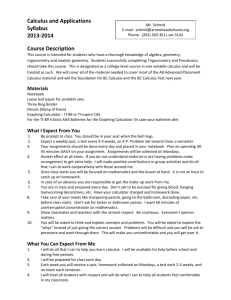MA1113 - SINGLE VARIABLE CALCULUS I (4-0)
advertisement
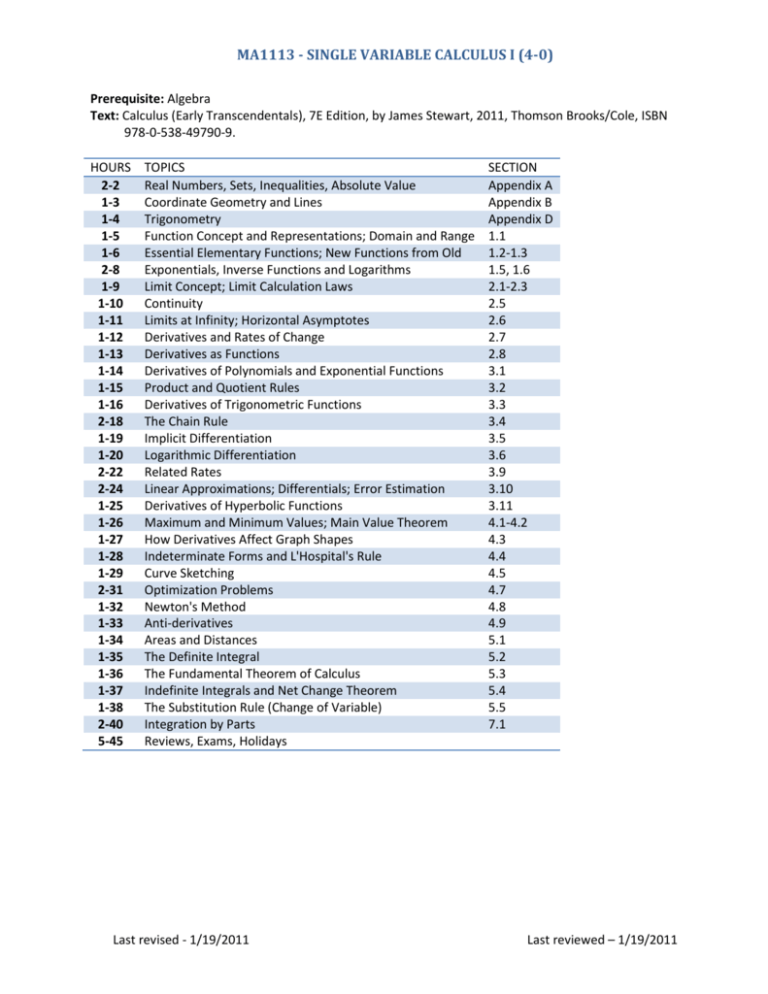
MA1113 - SINGLE VARIABLE CALCULUS I (4-0) Prerequisite: Algebra Text: Calculus (Early Transcendentals), 7E Edition, by James Stewart, 2011, Thomson Brooks/Cole, ISBN 978-0-538-49790-9. HOURS 2-2 1-3 1-4 1-5 1-6 2-8 1-9 1-10 1-11 1-12 1-13 1-14 1-15 1-16 2-18 1-19 1-20 2-22 2-24 1-25 1-26 1-27 1-28 1-29 2-31 1-32 1-33 1-34 1-35 1-36 1-37 1-38 2-40 5-45 TOPICS Real Numbers, Sets, Inequalities, Absolute Value Coordinate Geometry and Lines Trigonometry Function Concept and Representations; Domain and Range Essential Elementary Functions; New Functions from Old Exponentials, Inverse Functions and Logarithms Limit Concept; Limit Calculation Laws Continuity Limits at Infinity; Horizontal Asymptotes Derivatives and Rates of Change Derivatives as Functions Derivatives of Polynomials and Exponential Functions Product and Quotient Rules Derivatives of Trigonometric Functions The Chain Rule Implicit Differentiation Logarithmic Differentiation Related Rates Linear Approximations; Differentials; Error Estimation Derivatives of Hyperbolic Functions Maximum and Minimum Values; Main Value Theorem How Derivatives Affect Graph Shapes Indeterminate Forms and L'Hospital's Rule Curve Sketching Optimization Problems Newton's Method Anti-derivatives Areas and Distances The Definite Integral The Fundamental Theorem of Calculus Indefinite Integrals and Net Change Theorem The Substitution Rule (Change of Variable) Integration by Parts Reviews, Exams, Holidays Last revised - 1/19/2011 SECTION Appendix A Appendix B Appendix D 1.1 1.2-1.3 1.5, 1.6 2.1-2.3 2.5 2.6 2.7 2.8 3.1 3.2 3.3 3.4 3.5 3.6 3.9 3.10 3.11 4.1-4.2 4.3 4.4 4.5 4.7 4.8 4.9 5.1 5.2 5.3 5.4 5.5 7.1 Last reviewed – 1/19/2011 MA1113 - SINGLE VARIABLE CALCULUS I (4-0) Course Objectives Upon completion of this course, the student should have the following skills. Functions and limits Use real numbers, inequalities involving real numbers and their absolute values, the trigonometric functions, and the radian measure of angles. Be able to move back and forth between the descriptions of a function by an equation, a table, a graph, and by words. Be able to use exponential functions, sketch their graphs, and define the number e. Define what it means for a function to be one-to-one, and determine whether a function has an inverse or not and sketch its inverse if it does. Be able to use logarithmic functions, sketch their graphs, and define the relationship between the natural exponential and natural logarithmic functions. State in words what it means for a function to have a limit, be able to calculate limits, and be able to find the vertical and horizontal asymptotes of a function. State in words what it means for a function to be continuous, and be able to find limits for continuous functions. Derivatives Relate the notions of tangent to a curve, velocity, and rate of change, and illustrate them in a sketch. State the definition of derivative as the limit of a difference quotient, and explain how the derivative itself can be regarded as a function. Be able to find derivatives of polynomials and exponential functions. State the product and quotient rules for differentiation, and be able to use them to differentiate functions. Know the derivatives of sine and cosine, and be able to use the quotient rule to determine the derivatives of the remaining four trigonometric functions. State the chain rule, and use it to differentiate functions obtained by composition. Use the differentiation rules to differentiate implicitly, and to find higher order derivatives. Be able to differentiate logarithmic functions, and functions involving them. Define the hyperbolic functions and be able to differentiate them. Applications of Differentiation Be able to solve related rates problems. Understand them as an application of the chain rule. Understand the connection between the derivative, the tangent line to the graph of a function, the linearization of a function, and the differential of a function. Use the differential (or linearization) to solve “small change” and applied approximation problems. Be able to state the Mean Value Theorem, and give some of its consequences. Describe how the signs of the first and second derivatives of a function affect the shape of its graph. Be able to approximately and qualitatively accurately sketch the graph of a function. Define and recognize the various forms of indeterminate forms, and use L’Hospital’s Rule to determine their limits. Last revised - 1/19/2011 Last reviewed – 1/19/2011 MA1113 - SINGLE VARIABLE CALCULUS I (4-0) Be able to set up and solve optimization problems using calculus methods. Be able to describe Newton’s method geometrically, and to use it to iteratively approximate the zeros of functions. Define what the antiderivative of a function is, and be able to find it for reasonable functions. Integral Calculus Describe the connection between the problems of finding areas and distances travelled, and how both problems lead to the same limit. Explain what a Riemann sum is, what a definite integral is, and be able to work with the properties of definite integrals. State the Fundamental Theorem of Calculus in words, describe how it connects integral and differential calculus, and how it helps in finding antiderivatives and in evaluating definite integrals. Define the indefinite integral of a function and state its relation to the antiderivative. Describe the Total Change Theorem, and give examples of how it is used in applications. Recognize the Substitution Rule as an integral version of the chain rule, and be able to use the Substitution Rule to evaluate definite and indefinite integrals, and to extend the collection of functions that we can integrate. Recognize integration by parts as the integral version of the product rule, and be able to use it to evaluate appropriate integrals. Last revised - 1/19/2011 Last reviewed – 1/19/2011

